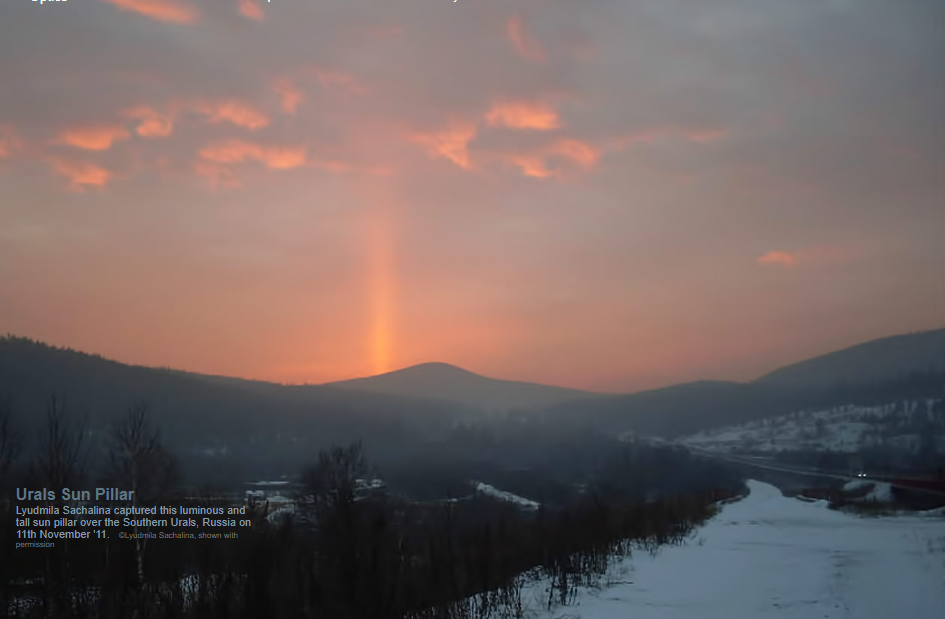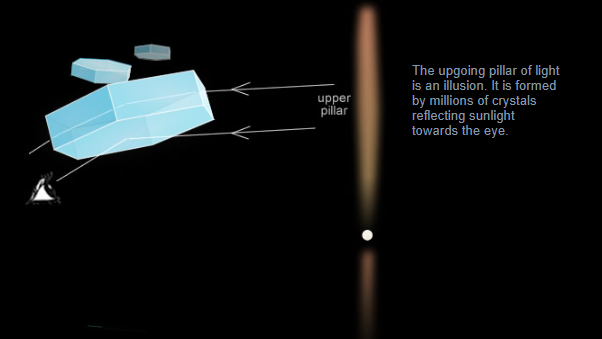OPOD - Urals Sun Pillar
OPOD - Urals Sun Pillar: A Captivating Atmospheric Phenomenon
The Urals Sun Pillar is a breathtaking atmospheric phenomenon that was captured by photographer Lyudmila Sachalina over the Southern Urals, Russia on November 11th, 2011. This luminous and tall sun pillar is a mesmerizing display of nature's beauty. Let's delve deeper into this fascinating occurrence and explore the science behind it.
The Enchanting Urals and its Sun Pillar
The Urals, known as the traditional boundary between Europe and Asia, are one of the oldest mountain ranges on Earth. These ancient mountains, formed approximately 250-300 million years ago, boast a rich abundance of minerals. The southern Urals reach an impressive height of 5380 feet, adding to the region's allure.
Unraveling the Formation of Sun Pillars
Sun pillars are typically formed by wobbly plate crystals, although column and Lowitz oriented crystals can also contribute to their creation. These plate crystals, although often less perfect than depicted in images, play a crucial role in reflecting the sun's rays.
When sunlight encounters these crystals, several ray paths can be observed. One path involves direct reflection from the lower face of the plate, while another path entails entry through a side face, internal reflection from the upper face (with possible channeling between the upper and lower faces), and eventual exit through an opposite side face. These intricate interactions result in the formation of the captivating sun pillar.
Dispelling Illusions: Understanding the Sun Pillar
Contrary to popular belief, there is no actual upward-going pillar of light. This visual illusion is caused by millions of reflections of the sun from individual crystals suspended in the atmosphere. Each crystal acts as a tiny mirror, reflecting and redirecting sunlight to create the illusion of a vertical column of light extending upwards.
A Deeper Dive into the Urals Sun Pillar
To truly appreciate the complexity and beauty of the Urals Sun Pillar, it is important to explore its intricacies. Here are some additional details about this captivating atmospheric phenomenon:
- The Urals Sun Pillar is a vertical column of light that appears to extend upwards from the horizon, often in the presence of cold temperatures and ice crystals in the atmosphere.
- The phenomenon occurs when the sun is low on the horizon, usually during sunrise or sunset, creating a stunning display of light and color.
- The height and intensity of the sun pillar can vary depending on atmospheric conditions and the size and shape of the ice crystals involved.
- While wobbly plate crystals are the primary contributors to sun pillar formation, other crystal shapes, such as columns and Lowitz oriented crystals, can also play a role.
- The Urals Sun Pillar is just one example of the many optical phenomena that can occur in the Earth's atmosphere, showcasing the awe-inspiring wonders of nature.
Appreciating Nature's Spectacles
The Urals Sun Pillar serves as a reminder of the beauty and complexity of our natural world. By understanding the scientific principles behind these atmospheric phenomena, we gain a deeper appreciation for the wonders that surround us. Next time you witness a sun pillar or any other captivating optical display, take a moment to marvel at the intricate dance of light and particles that create these mesmerizing spectacles.

Urals Sun Pillar
Lyudmila Sachalina captured this luminous and tall sun pillar over the Southern Urals, Russia on 11th November '11. ©Lyudmila Sachalina, shown with permission

The Urals, the traditional boundary between Europe and Asia are one of the planet's oldest mountain ranges formed some 250-300 million years ago and are rich in minerals. The southern Urals reach 5380 ft.
Wobbly plate crystals are the usual source of pillars although column and even Lowitz oriented crystals can form them.
The plates tend to be less perfect than those pictured at right. The sun's rays can be directly reflected from the plate's lower face. Another ray path is entry through a side face, internal reflection from the upper face (with possibly channeling between the upper and lower faces) followed by exit through an opposite side face.
There is no upward going pillar of light. That is an illusion. The 'pillar' is millions of reflections of the sun from individual crystals.
Note: this article has been automatically converted from the old site and may not appear as intended. You can find the original article here.
Reference Atmospheric Optics
If you use any of the definitions, information, or data presented on Atmospheric Optics, please copy the link or reference below to properly credit us as the reference source. Thank you!
-
<a href="https://atoptics.co.uk/blog/opod-urals-sun-pillar/">OPOD - Urals Sun Pillar</a>
-
"OPOD - Urals Sun Pillar". Atmospheric Optics. Accessed on November 26, 2024. https://atoptics.co.uk/blog/opod-urals-sun-pillar/.
-
"OPOD - Urals Sun Pillar". Atmospheric Optics, https://atoptics.co.uk/blog/opod-urals-sun-pillar/. Accessed 26 November, 2024
-
OPOD - Urals Sun Pillar. Atmospheric Optics. Retrieved from https://atoptics.co.uk/blog/opod-urals-sun-pillar/.